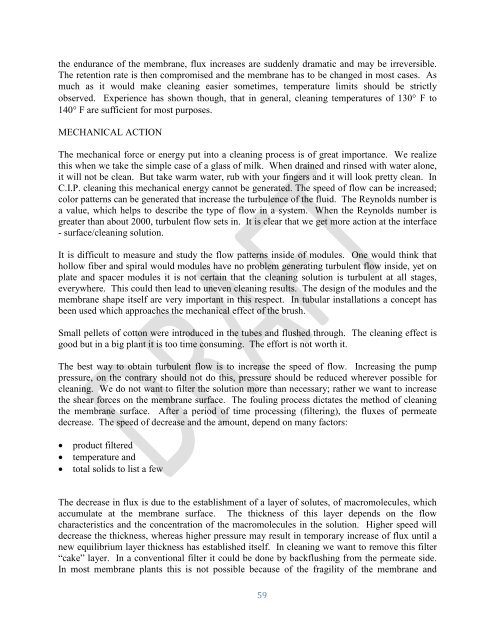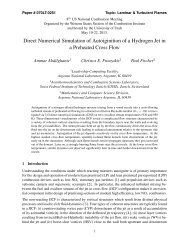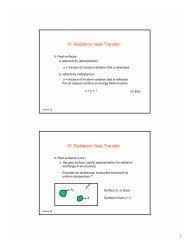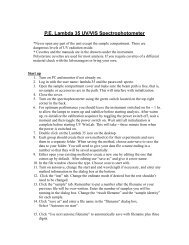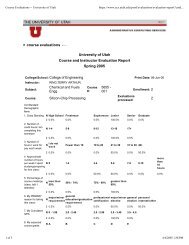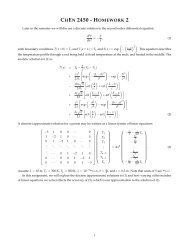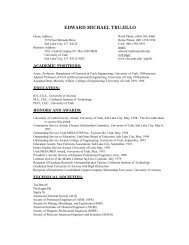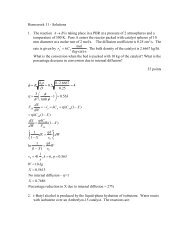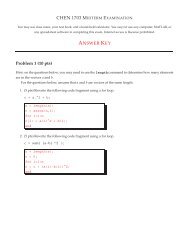Standard Operating Procedure - Ultrafiltration - Department of ...
Standard Operating Procedure - Ultrafiltration - Department of ...
Standard Operating Procedure - Ultrafiltration - Department of ...
- No tags were found...
You also want an ePaper? Increase the reach of your titles
YUMPU automatically turns print PDFs into web optimized ePapers that Google loves.
the endurance <strong>of</strong> the membrane, flux increases are suddenly dramatic and may be irreversible.The retention rate is then compromised and the membrane has to be changed in most cases. Asmuch as it would make cleaning easier sometimes, temperature limits should be strictlyobserved. Experience has shown though, that in general, cleaning temperatures <strong>of</strong> 130° F to140° F are sufficient for most purposes.MECHANICAL ACTIONThe mechanical force or energy put into a cleaning process is <strong>of</strong> great importance. We realizethis when we take the simple case <strong>of</strong> a glass <strong>of</strong> milk. When drained and rinsed with water alone,it will not be clean. But take warm water, rub with your fingers and it will look pretty clean. InC.I.P. cleaning this mechanical energy cannot be generated. The speed <strong>of</strong> flow can be increased;color patterns can be generated that increase the turbulence <strong>of</strong> the fluid. The Reynolds number isa value, which helps to describe the type <strong>of</strong> flow in a system. When the Reynolds number isgreater than about 2000, turbulent flow sets in. It is clear that we get more action at the interface- surface/cleaning solution.It is difficult to measure and study the flow patterns inside <strong>of</strong> modules. One would think thathollow fiber and spiral would modules have no problem generating turbulent flow inside, yet onplate and spacer modules it is not certain that the cleaning solution is turbulent at all stages,everywhere. This could then lead to uneven cleaning results. The design <strong>of</strong> the modules and themembrane shape itself are very important in this respect. In tubular installations a concept hasbeen used which approaches the mechanical effect <strong>of</strong> the brush.Small pellets <strong>of</strong> cotton were introduced in the tubes and flushed through. The cleaning effect isgood but in a big plant it is too time consuming. The effort is not worth it.The best way to obtain turbulent flow is to increase the speed <strong>of</strong> flow. Increasing the pumppressure, on the contrary should not do this, pressure should be reduced wherever possible forcleaning. We do not want to filter the solution more than necessary; rather we want to increasethe shear forces on the membrane surface. The fouling process dictates the method <strong>of</strong> cleaningthe membrane surface. After a period <strong>of</strong> time processing (filtering), the fluxes <strong>of</strong> permeatedecrease. The speed <strong>of</strong> decrease and the amount, depend on many factors:• product filtered• temperature and• total solids to list a fewThe decrease in flux is due to the establishment <strong>of</strong> a layer <strong>of</strong> solutes, <strong>of</strong> macromolecules, whichaccumulate at the membrane surface. The thickness <strong>of</strong> this layer depends on the flowcharacteristics and the concentration <strong>of</strong> the macromolecules in the solution. Higher speed willdecrease the thickness, whereas higher pressure may result in temporary increase <strong>of</strong> flux until anew equilibrium layer thickness has established itself. In cleaning we want to remove this filter“cake” layer. In a conventional filter it could be done by backflushing from the permeate side.In most membrane plants this is not possible because <strong>of</strong> the fragility <strong>of</strong> the membrane and59


